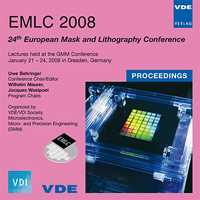EUV Blank Inspection
Konferenz: EMLC 2008 - 24th European Mask and Lithography Conference
21.01.2008 - 24.01.2008 in Dresden, Germany
Tagungsband: EMLC 2008
Seiten: 9Sprache: EnglischTyp: PDF
Persönliche VDE-Mitglieder erhalten auf diesen Artikel 10% Rabatt
Autoren:
Peters, J. H.; Tonk, C. (Advanced Mask Technology Center, Raehnitzer Allee 9, 01109 Dresden, Germany)
Spriegel, D. (Siemens AG, Corporate Technology, Otto-Hahn-Ring 6, 81739 München, Germany)
Han, Hak-Seung (SEMATECH, 255 Fuller Rd, Albany, NY 12144)
Wurm, Stefan (SEMATECH, 2706 Montopolis Drive, Austin, TX 78749-6499)
Inhalt:
One of the major topics for the introduction of extreme ultraviolet (EUV) technology is the availability of defect-free masks. From the mask makers' perspective, the quality of the incoming blank material is one of the key ingredients impacting the yield of structured masks. Besides flatness and layer thickness uniformity, the number of defects determines the final quality of the mask delivered to the customer for printing. Defects within the layers of optical blanks have shown that they have a growing impact on the mask structuring process, well below the usual defect specifications of the blanks. It is expected that this finding will also hold true for material layers above the multi-layer. In addition to printing performance, EUV masks need to have a defect-free multi-layer. While this layer is easily accessible during blank production, mask makers usually acquire the complete blank stacks with or without the coated resist. Incoming blank inspection, therefore, must check the quality of the complete stack without destroying any of the functionality of these layers. Siemens and AMTC have jointly developed a blank inspection tool that has been installed in AMTC's Dresden facility and that allows the screening of an EUV blank under these boundary conditions. Previously, SEMATECH successfully installed an M7360 from Lasertec in its Mask Blank Development Center (MBDC) in Albany, NY, that shows much better sensitivity data than SEMATECH's earlier tool, the Lasertec M1350. This paper describes the early performance of the Siemens DF-40XP on programmed multi-layer defect blanks and regular blanks and compares it to that of the existing tools at the SEMATECH MBDC.


